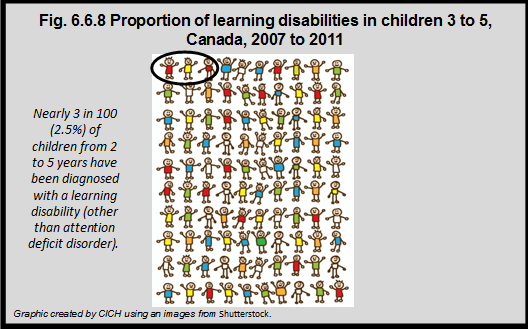Proportion of learning disabilities in children 3 to 5, Canada, 2007 to 2011

Source: CICH graphic created using data adapted from Statistics Canada, Canadian Health Measures Survey, 2010/11 – custom runs.
During the years 2007 to 2011, nearly 3 in 100 (2.5%) of children from ages 2 to 5 years were diagnosed with a learning disability (other than attention deficit disorder).
Boys are more likely than girls to have been diagnosed with learning disabilities.3
3Statistics Canada, Canadian Health Measures Survey, 2010/11 – custom runs.
Implications
Neurodevelopmental disorders among young children have been associated with exposure to environmental toxins.1,2
These are disorders that affect the neurological system and brain – for example attention-deficit/hyperactivity disorder (ADHD), autism, learning disabilities, intellectual disability, conduct disorders, cerebral palsy, and impairments in vision and hearing.
Lead, methylmercury, and polychlorinated biphenyls (PCBs) have been associated with negative effects on the developing brain and nervous system of the fetus and young children. This association has been shown in multiple studies. Exposure is widespread in Canada.1,2
There are other environmental toxins that have been identified as having potential concerns for the developing nervous system and brain – these have not been as widely studied, but young children are exposed to them in Canada.
They include the organophosphate pesticides, polybrominated diphenyl ether flame retardants (PBDEs)1, phthalates, bisphenol A (BPA), polycyclic aromatic hydrocarbons (PAHs), arsenic, and perchlorate.2
1Abelsohn AR and Sanborn M. Lead and children: Clinical management for family physicians. Canadian Family Physician June 2010 vol. 56 no. 6 531-535.
2Environmental Protection Agency. Children’s Health and the Environment Third Edition. 2013. https://www.epa.gov/sites/production/files/2015-06/documents/ace3_2013.pdf -accessed July 24, 2017.
